Metaverse & Human Digital Twin: Digital Identity, Biometrics, and Privacy in the Future Virtual Worlds
Abstract
1. Introduction
2. Background and Key Concepts
2.1. Digital Identity in the Metaverse
2.2. Human Digital Twin
3. Threats and Challenges of the HDT Frontier
3.1. Interoperability and Centralization
3.2. Immersivity and Wearable Devices
3.3. Expressive Representation Model
3.4. Binding Individuals to Their Digital Twins
3.5. Inclusive and Social Opportunity of the Metaverse
4. Key Enabling Technologies
4.1. Decentralized Identity
4.2. Non-Fungible and Soulbound Tokens
4.3. Advanced Biometric Authentication
4.4. Immersive Digital Environments
5. Harnessing HDT across Metaverse Worlds
5.1. Telemedicine and Personalized Care
- Consolidating all expertise in a centralized location, accessible remotely through AR/VR headsets, eradicates the necessity for physical travel.
- Enhanced data sharing and visualization within immersive VR and 3D environments facilitate the manipulation and augmentation of data through the integration of diverse sources.
- The capability to share data with disparate specialists enables multidisciplinary consultations and comparisons, despite physical separation.
- Leveraging telepresence technologies enables live 3D reconstruction, generating a real-time replica of the patient within the digital environment during consultations.
5.2. Immersive Learning
- Lecture scenario: access to the class will be restricted solely to students officially enrolled in the course, meaning those who can provide evidence of having successfully completed prerequisite courses and met associated requirements.
- Exam scenario: to authenticate the student’s identity, it would be necessary to verify the student ID, a facial image, enrollment in the exam, and any disability certificates (e.g., to provide appropriate support if needed). The authentication process could take place at the start of the exam, with the information accessible to the professor throughout the entire duration of the exam.
6. Conclusions
Author Contributions
Funding
Institutional Review Board Statement
Informed Consent Statement
Data Availability Statement
Conflicts of Interest
References
- Sen, K.; Prybutok, G.; Prybutok, V. The use of digital technology for social wellbeing reduces social isolation in older adults: A systematic review. SSM-Popul. Health 2022, 17, 101020. [Google Scholar] [CrossRef] [PubMed]
- OECD. Educating 21st Century Children; OECD’s Centre for Educational Research and Innovations: Paris, France, 2019; p. 284. [Google Scholar] [CrossRef]
- Othman, A.; Chemnad, K.; Hassanien, A.E.; Tlili, A.; Zhang, C.Y.; Al-Thani, D.; Altınay, F.; Chalghoumi, H.S.; Al-Khalifa, H.; Obeid, M.; et al. Accessible Metaverse: A Theoretical Framework for Accessibility and Inclusion in the Metaverse. Multimodal Technol. Interact. 2024, 8, 21. [Google Scholar] [CrossRef]
- Radanliev, P.; De Roure, D.; Novitzky, P.; Sluganovic, I. Accessibility and inclusiveness of new information and communication technologies for disabled users and content creators in the Metaverse. Disabil. Rehabil. Assist. Technol. 2023, 1–15. [Google Scholar] [CrossRef] [PubMed]
- Miller, M.E.; Spatz, E. A unified view of a human digital twin. Hum.-Intell. Syst. Integr. 2022, 4, 23–33. [Google Scholar] [CrossRef]
- Lauer-Schmaltz, M.W.; Cash, P.; Hansen, J.P.; Maier, A. Towards the Human Digital Twin: Definition and Design—A survey. arXiv 2024, arXiv:2402.07922. [Google Scholar]
- Turk, Ž. Interoperability in construction–Mission impossible? Dev. Built Environ. 2020, 4, 100018. [Google Scholar] [CrossRef]
- Borkowski, A.S. Evolution of BIM: Epistemology, genesis and division into periods. J. Inf. Technol. Constr. 2023, 28, 646–661. [Google Scholar] [CrossRef]
- Yang, L.; Ni, S.T.; Wang, Y.; Yu, A.; Lee, J.A.; Hui, P. Interoperability of the Metaverse: A Digital Ecosystem Perspective Review. arXiv 2024, arXiv:2403.05205. [Google Scholar]
- Al-kfairy, M.; Alomari, A.; Al-Bashayreh, M.G.; Tubishat, M. Unveiling the Metaverse: A survey of user perceptions and the impact of usability, social influence and interoperability. Heliyon 2024, 10, e31413. [Google Scholar] [CrossRef]
- Shumba, A.T.; Montanaro, T.; Sergi, I.; Bramanti, A.; Ciccarelli, M.; Rispoli, A.; Carrizzo, A.; De Vittorio, M.; Patrono, L. Wearable technologies and ai at the far edge for chronic heart failure prevention and management: A systematic review and prospects. Sensors 2023, 23, 6896. [Google Scholar] [CrossRef]
- Wang, S.; Wang, W. A review of the application of digital identity in the metaverse. Secur. Saf. 2023, 2, 2023009. [Google Scholar] [CrossRef]
- Mitrushchenkova, A.N. Personal identity in the metaverse: Challenges and risks. Kutafin Law Rev. 2023, 9, 793–817. [Google Scholar] [CrossRef]
- Wu, H.; Zhang, W. Digital identity, privacy security, and their legal safeguards in the Metaverse. Secur. Saf. 2023, 2, 2023011. [Google Scholar] [CrossRef]
- Forum, W.E. Metaverse Identity: Defining the Self in a Blended Reality. 2024. Available online: https://www.weforum.org/publications/metaverse-identity-defining-the-self-in-a-blended-reality/ (accessed on 2 June 2024).
- Liu, M.; Fang, S.; Dong, H.; Xu, C. Review of digital twin about concepts, technologies, and industrial applications. J. Manuf. Syst. 2021, 58, 346–361. [Google Scholar] [CrossRef]
- Fuller, A.; Fan, Z.; Day, C.; Barlow, C. Digital twin: Enabling technologies, challenges and open research. IEEE Access 2020, 8, 108952–108971. [Google Scholar] [CrossRef]
- Bisanti, G.M.; Mainetti, L.; Montanaro, T.; Patrono, L.; Sergi, I. Digital twins for aircraft maintenance and operation: A systematic literature review and an IoT-enabled modular architecture. Internet Things 2023, 24, 100991. [Google Scholar] [CrossRef]
- Cheng, Z. Human digital twin with applications. In Proceedings of the 7th International Digital Human Modeling Symposium, Iowa City, IA, USA, 29–30 August 2022; University of Iowa: Iowa City, IA, USA, 2022; Volume 7. [Google Scholar]
- Barricelli, B.R.; Casiraghi, E.; Gliozzo, J.; Petrini, A.; Valtolina, S. Human digital twin for fitness management. IEEE Access 2020, 8, 26637–26664. [Google Scholar] [CrossRef]
- Sparrow, D.; Kruger, K.; Basson, A. Human Digital Twin for Integrating Human Workers in Industry. In Proceedings of the International Conference on Competitive Manufacturing (COMA 19) Proceedings, Stellenbosch, South Africa, 30 January–1 February 2019; p. 259. [Google Scholar]
- de Kerckhove, D. The personal digital twin, ethical considerations. Philos. Trans. R. Soc. A 2021, 379, 20200367. [Google Scholar] [CrossRef] [PubMed]
- Song, Y. Human digital twin, the development and impact on design. J. Comput. Inf. Sci. Eng. 2023, 23, 060819. [Google Scholar] [CrossRef]
- Fintz, M.; Osadchy, M.; Hertz, U. Using deep learning to predict human decisions and using cognitive models to explain deep learning models. Sci. Rep. 2022, 12, 4736. [Google Scholar] [CrossRef]
- He, Q.; Li, L.; Li, D.; Peng, T.; Zhang, X.; Cai, Y.; Zhang, X.; Tang, R. From Digital Human Modeling to Human Digital Twin: Framework and Perspectives in Human Factors. Chin. J. Mech. Eng. 2024, 37, 9. [Google Scholar] [CrossRef]
- Dahia, G.; Jesus, L.; Pamplona Segundo, M. Continuous authentication using biometrics: An advanced review. Wiley Interdiscip. Rev. Data Min. Knowl. Discov. 2020, 10, e1365. [Google Scholar] [CrossRef]
- Park, J.S.; Lee, D.G.; Jimenez, J.A.; Lee, S.J.; Kim, J.W. Human-focused digital twin applications for occupational safety and health in workplaces: A brief survey and research directions. Appl. Sci. 2023, 13, 4598. [Google Scholar] [CrossRef]
- Ramadhani, N.; Fachri, M.; Prasetyo, D.; Damastuti, F.A.; Hariadi, M.; Mutiaz, I.R. Virtual Avatar Representation in the Digital Twin: A Photogrammetric Three-Dimentional Modeling Approach. In Proceedings of the 2023 Eighth International Conference on Informatics and Computing (ICIC), Manado, Indonesia, 8–9 December 2023; IEEE: Piscataway Township, NJ, USA, 2023; pp. 1–7. [Google Scholar]
- Chaudhary, S.; Schafeitel-Tähtinen, T.; Helenius, M.; Berki, E. Usability, security and trust in password managers: A quest for user-centric properties and features. Comput. Sci. Rev. 2019, 33, 69–90. [Google Scholar] [CrossRef]
- Alizadeh, M.; Andersson, K.; Schelén, O. Comparative analysis of decentralized identity approaches. IEEE Access 2022, 10, 92273–92283. [Google Scholar] [CrossRef]
- Ruiu, P.; Lagorio, A.; Cadoni, M.; Grosso, E. Enhancing eID card mobile-based authentication through 3D facial reconstruction. J. Inf. Secur. Appl. 2023, 77, 103577. [Google Scholar] [CrossRef]
- Ghirmai, S.; Mebrahtom, D.; Aloqaily, M.; Guizani, M.; Debbah, M. Self-sovereign identity for trust and interoperability in the metaverse. In Proceedings of the 2022 IEEE Smartworld, Ubiquitous Intelligence & Computing, Scalable Computing & Communications, Digital Twin, Privacy Computing, Metaverse, Autonomous & Trusted Vehicles (SmartWorld/UIC/ScalCom/DigitalTwin/PriComp/Meta), Haikou, China, 15–18 December 2022; IEEE: Piscataway Township, NJ, USA, 2022; pp. 2468–2475. [Google Scholar]
- Zyda, M. Let’s rename everything “the Metaverse!”. Computer 2022, 55, 124–129. [Google Scholar] [CrossRef]
- Nair, V.; Garrido, G.M.; Song, D.; O’Brien, J. Exploring the privacy risks of adversarial VR game design. Proc. Priv. Enhancing Technol. 2023, 4, 238–256. [Google Scholar] [CrossRef]
- Bye, K.; Hosfelt, D.; Chase, S.; Miesnieks, M.; Beck, T. The ethical and privacy implications of mixed reality. In Proceedings of the ACM SIGGRAPH 2019 Panels, Los Angeles, CA, USA, 28 July 2019; pp. 1–2. [Google Scholar]
- Heller, B. Watching androids dream of electric sheep: Immersive technology, biometric psychography, and the law. Vand. J. Ent. Tech. L. 2020, 23, 1. [Google Scholar]
- Kshatri, S.S.; Singh, D.; Goswami, T.; Sinha, G. Introduction to statistical modeling in machine learning: A case study. In Statistical Modeling in Machine Learning; Elsevier: Amsterdam, The Netherlands, 2023; pp. 1–21. [Google Scholar]
- Ríos-Sánchez, B.; Silva, D.C.d.; Martín-Yuste, N.; Sánchez-Ávila, C. Deep learning for face recognition on mobile devices. IET Biom. 2020, 9, 109–117. [Google Scholar] [CrossRef]
- Cadoni, M.; Lagorio, A.; Grosso, E. Large scale face identification by combined iconic features and 3d joint invariant signatures. Image Vis. Comput. 2016, 52, 42–55. [Google Scholar] [CrossRef]
- Cadoni, M.; Lagorio, A.; Grosso, E. Do CNN’s features correlate with human fixations? In Proceedings of the 3rd International Conference on Applications of Intelligent Systems, Las Palmas de Gran Canaria, Spain, 7–12 January 2020; pp. 1–6. [Google Scholar]
- Cadoni, M.; Lagorio, A.; Khellat-Kihel, S.; Grosso, E. On the correlation between human fixations, handcrafted and CNN features. Neural Comput. Appl. 2021, 33, 11905–11922. [Google Scholar] [CrossRef]
- Henz, P. The societal impact of the metaverse. Perspective 2022, 2, 19. [Google Scholar] [CrossRef]
- Wang, Y.; Su, Z.; Yan, M. Social metaverse: Challenges and solutions. IEEE Internet Things Mag. 2023, 6, 144–150. [Google Scholar] [CrossRef]
- Hutson, J. Social virtual reality: Neurodivergence and inclusivity in the metaverse. Societies 2022, 12, 102. [Google Scholar] [CrossRef]
- Zallio, M.; Clarkson, P.J. Designing the metaverse: A study on inclusion, diversity, equity, accessibility and safety for digital immersive environments. Telemat. Inform. 2022, 75, 101909. [Google Scholar] [CrossRef]
- Bedard, A.; Zhang, Q. Building an Inclusive Metaverse: Opening Doors to a Brighter Digital Future. In Proceedings of the International Conference on Human-Computer Interaction, Copenhagen, Denmark, 23–28 July 2023; Springer: Berlin/Heidelberg, Germany, 2023; pp. 333–351. [Google Scholar]
- Zhu, H.Y.; Hieu, N.Q.; Hoang, D.T.; Nguyen, D.N.; Lin, C.T. A human-centric metaverse enabled by brain-computer interface: A survey. IEEE Commun. Surv. Tutor. 2024. [Google Scholar] [CrossRef]
- Almufareh, M.F.; Kausar, S.; Humayun, M.; Tehsin, S. A Conceptual Model for Inclusive Technology: Advancing Disability Inclusion through Artificial Intelligence. J. Disabil. Res. 2024, 3, 20230060. [Google Scholar] [CrossRef]
- Luna-Romero, S.F.; Stempniak, C.R.; de Souza, M.A.; Reynoso-Meza, G. Urban Digital Twins for Synthetic Data of Individuals with Mobility Aids in Curitiba, Brazil, to Drive Highly Accurate AI Models for Inclusivity. In Proceedings of the International Conference on Science, Technology and Innovation for Society, Leiden, The Netherlands, 27–29 September 2023; Springer: Berlin/Heidelberg, Germany, 2023; pp. 116–125. [Google Scholar]
- Bennett, R.; Vijaygopal, R. Exploring mobility and transportation technology futures for people with ambulatory disabilities: A science fiction prototype. Technovation 2024, 133, 103001. [Google Scholar] [CrossRef]
- Yenduri, G.; Kaluri, R.; Rajput, D.S.; Lakshmanna, K.; Gadekallu, T.R.; Mahmud, M.; Brown, D.J. From Assistive Technologies to Metaverse–Technologies in Inclusive Higher Education for Students with Specific Learning Difficulties: A Review. IEEE Access 2023, 11, 64907–64927. [Google Scholar] [CrossRef]
- Ascone, C.; Vanderhaegen, F. Towards a holistic framework for digital twins of human-machine systems. IFAC-PapersOnLine 2022, 55, 67–72. [Google Scholar] [CrossRef]
- Bai, Y.; Lei, H.; Li, S.; Gao, H.; Li, J.; Li, L. Decentralized and self-sovereign identity in the era of blockchain: A survey. In Proceedings of the 2022 IEEE International Conference on Blockchain (Blockchain), Espoo, Finland, 22–25 August 2022; IEEE: Piscataway Township, NJ, USA, 2022; pp. 500–507. [Google Scholar]
- Naik, N.; Jenkins, P. uPort open-source identity management system: An assessment of self-sovereign identity and user-centric data platform built on blockchain. In Proceedings of the 2020 IEEE International Symposium on Systems Engineering (ISSE), Vienna, Austria, 12 October–12 November 2020; IEEE: Piscataway Township, NJ, USA, 2020; pp. 1–7. [Google Scholar]
- Tobin, A.; Reed, D. The inevitable rise of self-sovereign identity. Sovrin Found. 2016, 29, 18. [Google Scholar]
- Stokkink, Q.; Pouwelse, J. Deployment of a blockchain-based self-sovereign identity. In Proceedings of the 2018 IEEE International Conference on Internet of Things (iThings) and IEEE Green Computing and Communications (GreenCom) and IEEE Cyber, Physical and Social Computing (CPSCom) and IEEE Smart Data (SmartData), Halifax, NS, Canada, 30 July–3 August 2018; IEEE: Piscataway Township, NJ, USA, 2018; pp. 1336–1342. [Google Scholar]
- Banaeian Far, S.; Hosseini Bamakan, S.M. NFT-based identity management in metaverses: Challenges and opportunities. SN Appl. Sci. 2023, 5, 260. [Google Scholar] [CrossRef]
- Weyl, E.G.; Ohlhaver, P.; Buterin, V. Decentralized Society: Finding web3’s Soul. Available online: https://www.microsoft.com/en-us/research/publication/decentralized-society-finding-web3s-soul/ (accessed on 2 June 2024).
- Reddy, S.; Kushwaha, D.S. Framework for privacy preserving credential issuance and verification system using soulbound token. In ITM Web of Conferences; EDP Sciences: Les Ulis, France, 2023; Volume 56, p. 06002. [Google Scholar]
- Chaffer, T.J.; Goldston, J. On the Existential Basis of Self-Sovereign Identity and Soulbound Tokens: An Examination of the “Self” in the Age of Web3. J. Strateg. Innov. Sustain. 2022, 17, 1–9. [Google Scholar]
- Kim, G.; Ryou, J. Digital Authentication System in Avatar Using DID and SBT. Mathematics 2023, 11, 4387. [Google Scholar] [CrossRef]
- Fenu, G.; Marras, M.; Boratto, L. A multi-biometric system for continuous student authentication in e-learning platforms. Pattern Recognit. Lett. 2018, 113, 83–92. [Google Scholar] [CrossRef]
- Mahfouz, A.; Mahmoud, T.M.; Eldin, A.S. A survey on behavioral biometric authentication on smartphones. J. Inf. Secur. Appl. 2017, 37, 28–37. [Google Scholar] [CrossRef]
- Ruiu, P.; Caragnano, G.; Masala, G.L.; Grosso, E. Accessing cloud services through biometrics authentication. In Proceedings of the 2016 10th International Conference on Complex, Intelligent, and Software Intensive Systems (CISIS), Fukuoka, Japan, 6–8 July 2016; IEEE: Piscataway Township, NJ, USA, 2016; pp. 38–43. [Google Scholar]
- Wang, Y.; Su, Z.; Zhang, N.; Xing, R.; Liu, D.; Luan, T.H.; Shen, X. A survey on metaverse: Fundamentals, security, and privacy. IEEE Commun. Surv. Tutor. 2022, 25, 319–352. [Google Scholar] [CrossRef]
- Falchuk, B.; Loeb, S.; Neff, R. The social metaverse: Battle for privacy. IEEE Technol. Soc. Mag. 2018, 37, 52–61. [Google Scholar] [CrossRef]
- Berbecaru, D.; Lioy, A.; Cameroni, C. Authorize-then-authenticate: Supporting authorization decisions prior to authentication in an electronic identity infrastructure. In Intelligent Distributed Computing XIII; Springer: Berlin/Heidelberg, Germany, 2020; pp. 313–322. [Google Scholar]
- Hanaoka, K.; Ngan, M.L.; Grother, P.J.; Hom, A. Ongoing Face Recognition Vendor Test (FRVT) Part 9a: Face Recognition Verification Accuracy on Distinguishing Twins; National Institute of Standards and Technology: Gaithersburg, MD, USA, 2022. [Google Scholar]
- Li, Y.; Zou, B.; Deng, S.; Zhou, G. Using feature fusion strategies in continuous authentication on smartphones. IEEE Internet Comput. 2020, 24, 49–56. [Google Scholar] [CrossRef]
- Kumar, R.; Phoha, V.V.; Serwadda, A. Continuous authentication of smartphone users by fusing typing, swiping, and phone movement patterns. In Proceedings of the 2016 IEEE 8th International Conference on Biometrics Theory, Applications and Systems (BTAS), Niagara Falls, NY, USA, 6–9 September 2016; IEEE: Piscataway Township, NJ, USA; 2016; pp. 1–8. [Google Scholar]
- Huang, H.; Zeng, X.; Zhao, L.; Qiu, C.; Wu, H.; Fan, L. Fusion of building information modeling and blockchain for metaverse: A survey. IEEE Open J. Comput. Soc. 2022, 3, 195–207. [Google Scholar] [CrossRef]
- García de Soto, B.; Turk, Ž.; Maciel, A.; Mantha, B.; Georgescu, A.; Sonkor, M.S. Understanding the significance of cybersecurity in the construction industry: Survey findings. J. Constr. Eng. Manag. 2022, 148, 04022095. [Google Scholar] [CrossRef]
- Turk, Ž.; Sonkor, M.S.; Klinc, R. Cybersecurity assessment of BIM/CDE design environment using cyber assessment framework. J. Civ. Eng. Manag. 2022, 28, 349–364. [Google Scholar] [CrossRef]
- Hadavi, A.; Alizadehsalehi, S. From BIM to metaverse for AEC industry. Autom. Constr. 2024, 160, 105248. [Google Scholar] [CrossRef]
- Murroni, M.; Anedda, M.; Fadda, M.; Ruiu, P.; Popescu, V.; Zaharia, C.; Giusto, D. 6G—Enabling the New Smart City: A Survey. Sensors 2023, 23, 7528. [Google Scholar] [CrossRef]
- Ruiu, P.; Mascia, L.; Grosso, E. Saliency-Guided Point Cloud Compression for 3D Live Reconstruction. Multimodal Technol. Interact. 2024, 8, 36. [Google Scholar] [CrossRef]
- Baggio, G.; Corsini, A.; Floreani, A.; Giannini, S.; Zagonel, V. Gender medicine: A task for the third millennium. Clin. Chem. Lab. Med. (CCLM) 2013, 51, 713–727. [Google Scholar] [CrossRef] [PubMed]
- Li, Y.; Gunasekeran, D.V.; RaviChandran, N.; Tan, T.F.; Ong, J.C.L.; Thirunavukarasu, A.J.; Polascik, B.W.; Habash, R.; Khaderi, K.; Ting, D.S. The next generation of healthcare ecosystem in the metaverse. Biomed. J. 2023, 100679. [Google Scholar] [CrossRef] [PubMed]
- Gammariello, M.C.; Sergi, I.; Montanaro, T.; Shumba, A.T.; Mazzeo, P.L.; Patrono, L.; Distante, C. SpO2 Estimation Using Deep Neural Networks: A Comparative Study. In Proceedings of the 2023 8th International Conference on Smart and Sustainable Technologies (SpliTech), Bol, Croatia, 20–23 June 2023; IEEE: Piscataway Township, NJ, USA, 2023; pp. 1–6. [Google Scholar]
- Sergi, I.; Montanaro, T.; Shumba, A.T.; Bramanti, A.; Ciccarelli, M.; Carrizzo, A.; Visconti, P.; De Vittorio, M.; Patrono, L. An IoT-aware system for remote monitoring of patients with chronic heart failure. In Proceedings of the 2023 8th International Conference on Smart and Sustainable Technologies (SpliTech), Bol, Croatia, 20–23 June 2023; IEEE: Piscataway Township, NJ, USA, 2023; pp. 1–5. [Google Scholar]
- Silcox, C.; Zimlichmann, E.; Huber, K.; Rowen, N.; Saunders, R.; McClellan, M.; Kahn III, C.N.; Salzberg, C.A.; Bates, D.W. The potential for artificial intelligence to transform healthcare: Perspectives from international health leaders. Npj Digit. Med. 2024, 7, 88. [Google Scholar] [CrossRef]
- Shumba, A.T.; Montanaro, T.; Sergi, I.; Fachechi, L.; De Vittorio, M.; Patrono, L. Leveraging IoT-aware technologies and AI techniques for real-time critical healthcare applications. Sensors 2022, 22, 7675. [Google Scholar] [CrossRef]
- Hasani, N.; Farhadi, F.; Morris, M.A.; Nikpanah, M.; Rahmim, A.; Xu, Y.; Pariser, A.; Collins, M.T.; Summers, R.M.; Jones, E.; et al. Artificial intelligence in medical imaging and its impact on the rare disease community: Threats, challenges and opportunities. PET Clin. 2022, 17, 13–29. [Google Scholar] [CrossRef] [PubMed]
- Bruno, R.R.; Wolff, G.; Wernly, B.; Masyuk, M.; Piayda, K.; Leaver, S.; Erkens, R.; Oehler, D.; Afzal, S.; Heidari, H.; et al. Virtual and augmented reality in critical care medicine: The patient’s, clinician’s, and researcher’s perspective. Crit. Care 2022, 26, 326. [Google Scholar] [CrossRef] [PubMed]
- Cerritelli, F.; Chiera, M.; Abbro, M.; Megale, V.; Esteves, J.; Gallace, A.; Manzotti, A. The challenges and perspectives of the integration between virtual and augmented reality and manual therapies. Front. Neurol. 2021, 12, 700211. [Google Scholar] [CrossRef] [PubMed]
- Levantesi, S. Assessing Italy’s climate risk. Nature 2021. Available online: https://www.nature.com/articles/d43978-021-00136-0 (accessed on 2 June 2024). [CrossRef]
- Unesco; UNICEF; Banco Internacional de Reconstrucción y Fomento. The State of the Global Education Crisis: A Path to Recovery: A Joint UNESCO, UNICEF and WORLD BANK Report; UNESCO: Paris, France, 2021. [Google Scholar]
- Han, E.; Bailenson, J.N. Lessons for/in virtual classrooms: Designing a model for classrooms inside virtual reality. Commun. Educ. 2024, 73, 234–243. [Google Scholar] [CrossRef]
- of South Wales, U. USW Tech Experts Helping to Develop Virtual Reality ‘Mediverse’ for Training Medics. 2022. Available online: https://www.southwales.ac.uk/news/news-2022/usw-tech-experts-helping-to-develop-virtual-reality-mediverse-for-training-medics/ (accessed on 2 June 2024).
- Meta. Meta University. 2024. Available online: https://www.metacareers.com/careerprograms/pathways/metauniversity (accessed on 2 June 2024).
- Tejashwin, U.; Kennith, S.; Manivel, R.; Devi, M.T.S.; Nirmala, M. Decentralised Society Using Soulbound Tokens. In Proceedings of the 2023 3rd Asian Conference on Innovation in Technology (ASIANCON), Pune, India, 23–25 August 2024; IEEE: Piscataway Township, NJ, USA, 2023; pp. 1–5. [Google Scholar]
- Grech, A.; Sood, I.; Ariño, L. Blockchain, self-sovereign identity and digital credentials: Promise versus praxis in education. Front. Blockchain 2021, 4, 616779. [Google Scholar] [CrossRef]
- Queiruga-Dios, A.; Pérez, J.J.B.; Encinas, L.H. Self-sovereign identity in university context. In Proceedings of the 2022 31st Conference of Open Innovations Association (FRUCT), Helsinki, Finland, 27–29 April 2022; IEEE: Piscataway Township, NJ, USA, 2022; pp. 259–264. [Google Scholar]
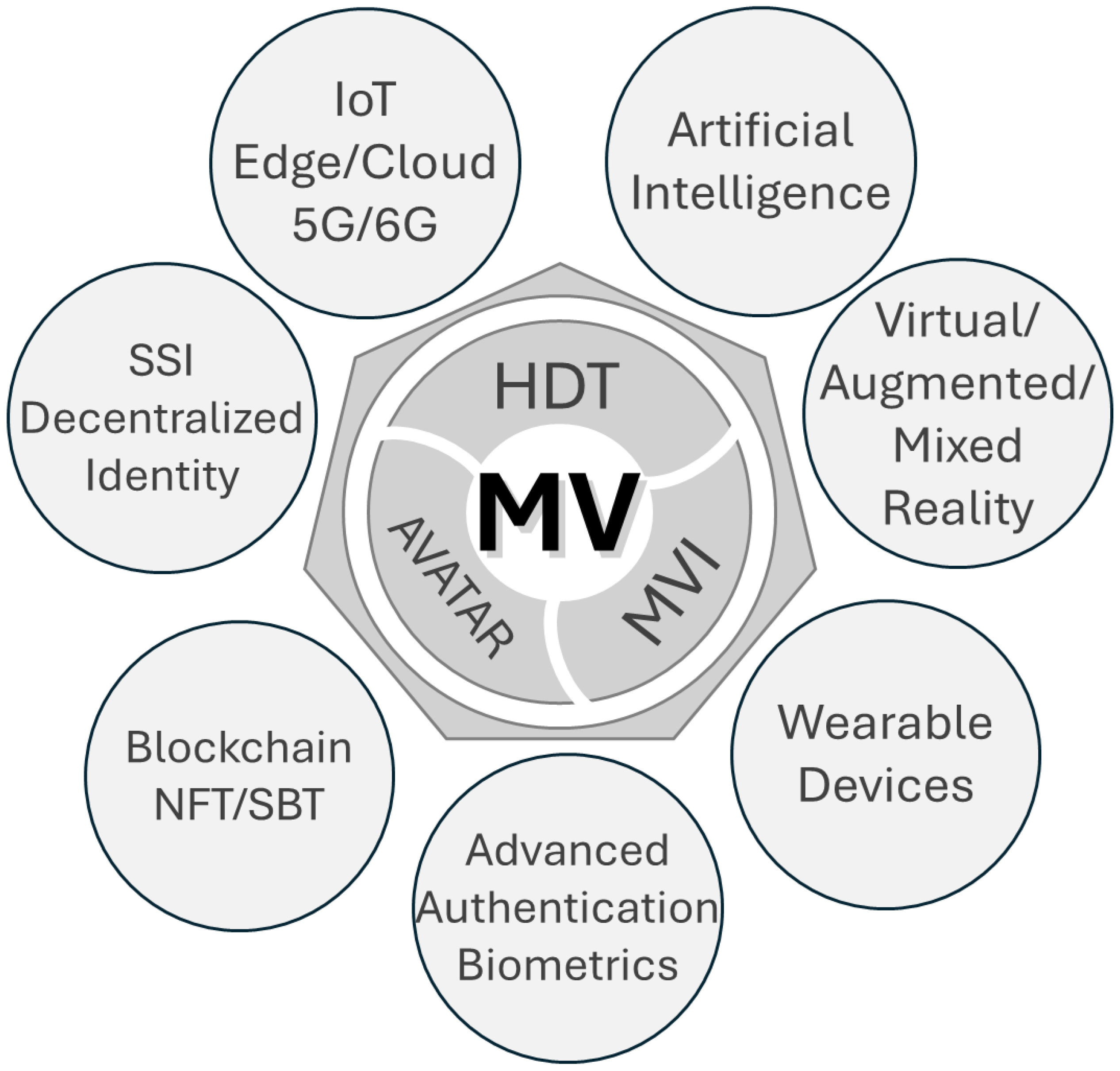




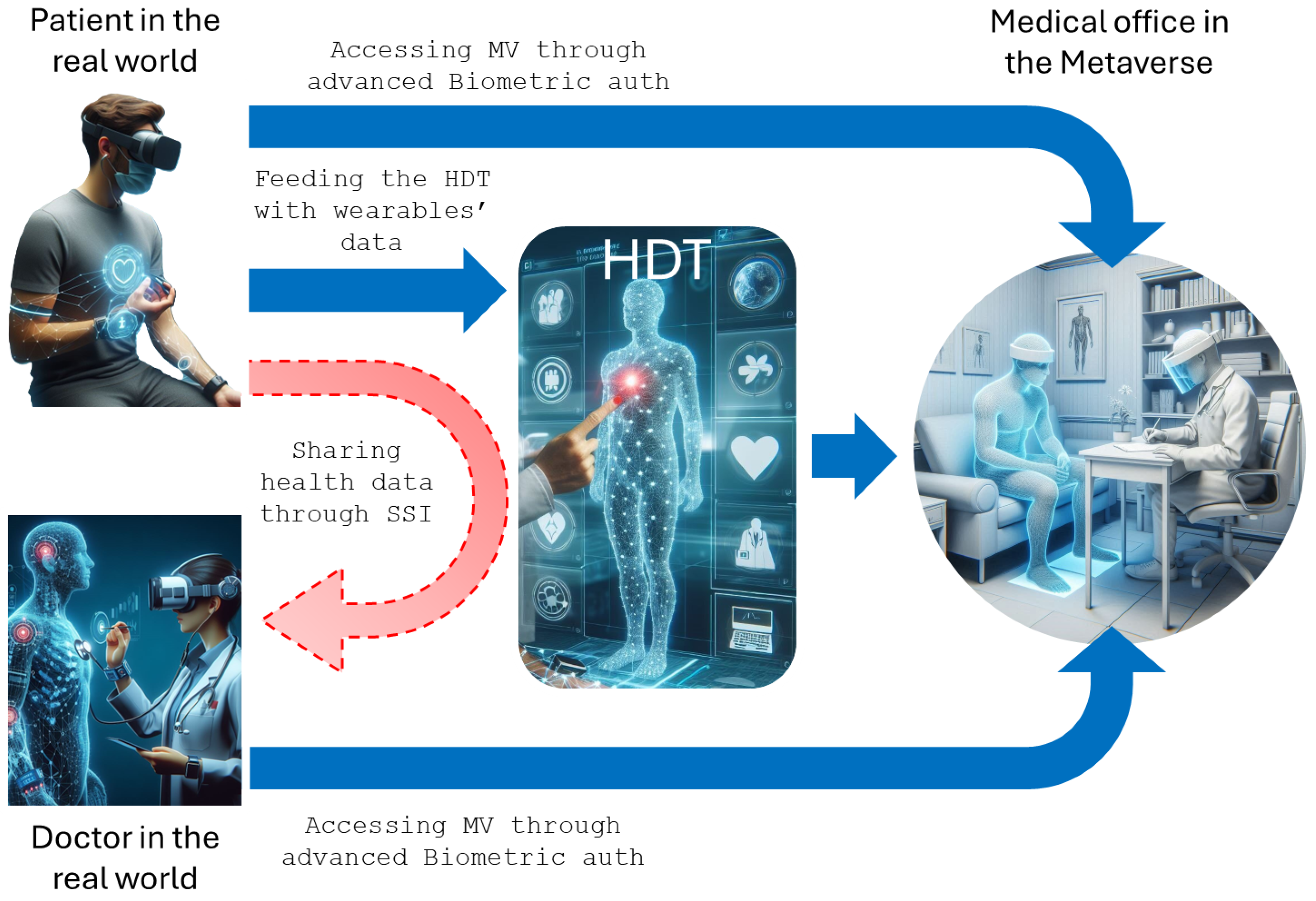
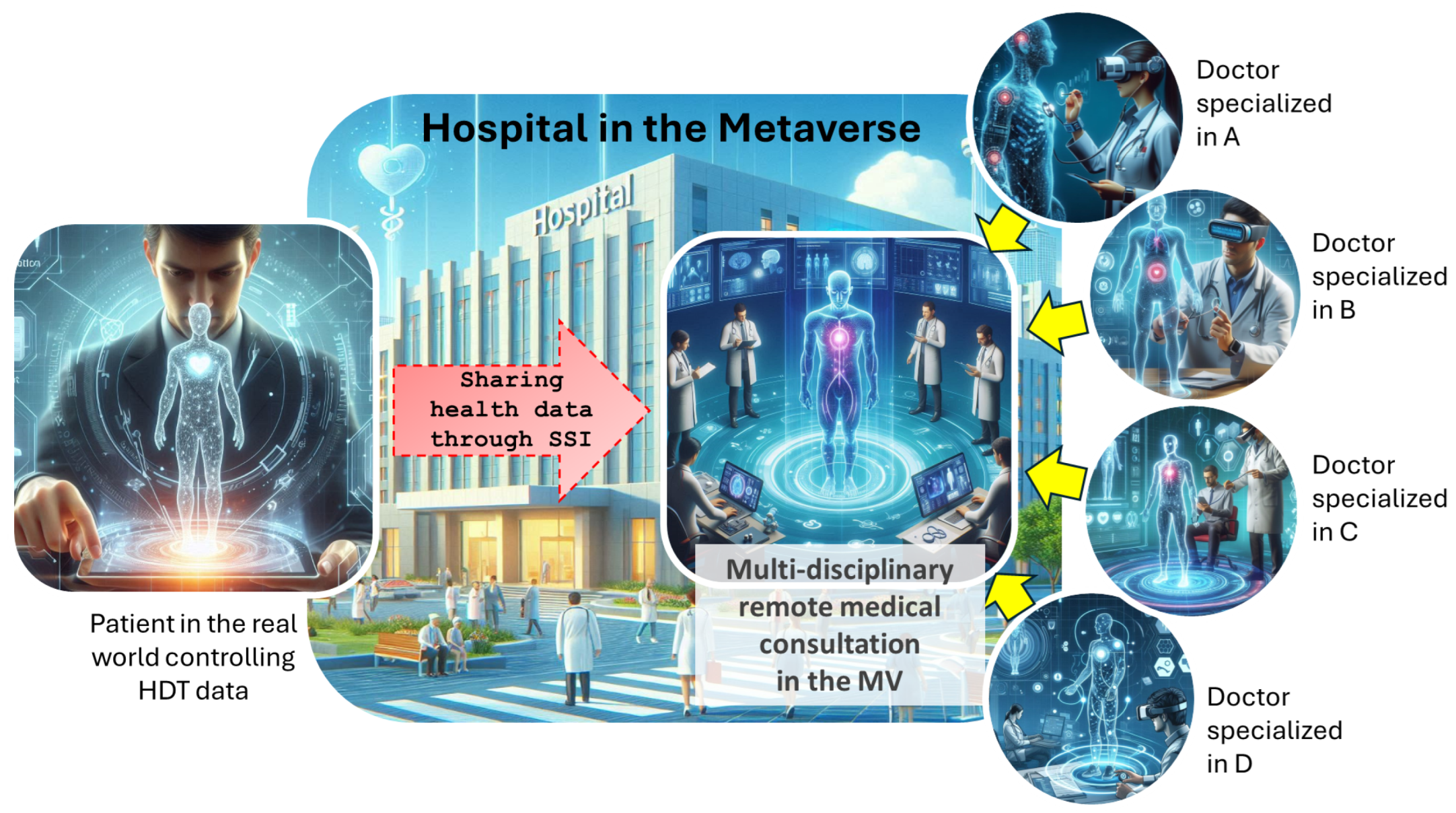
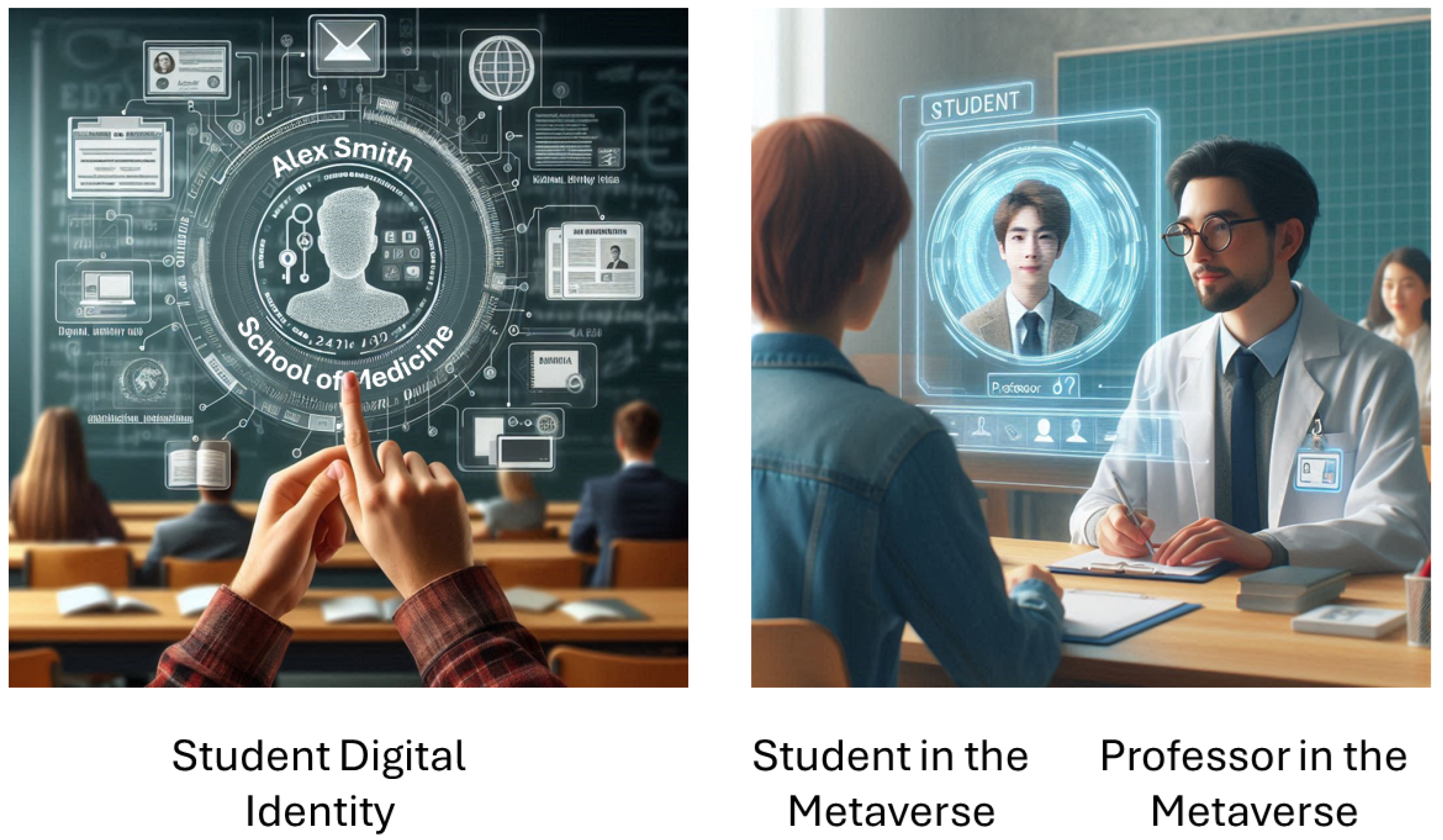
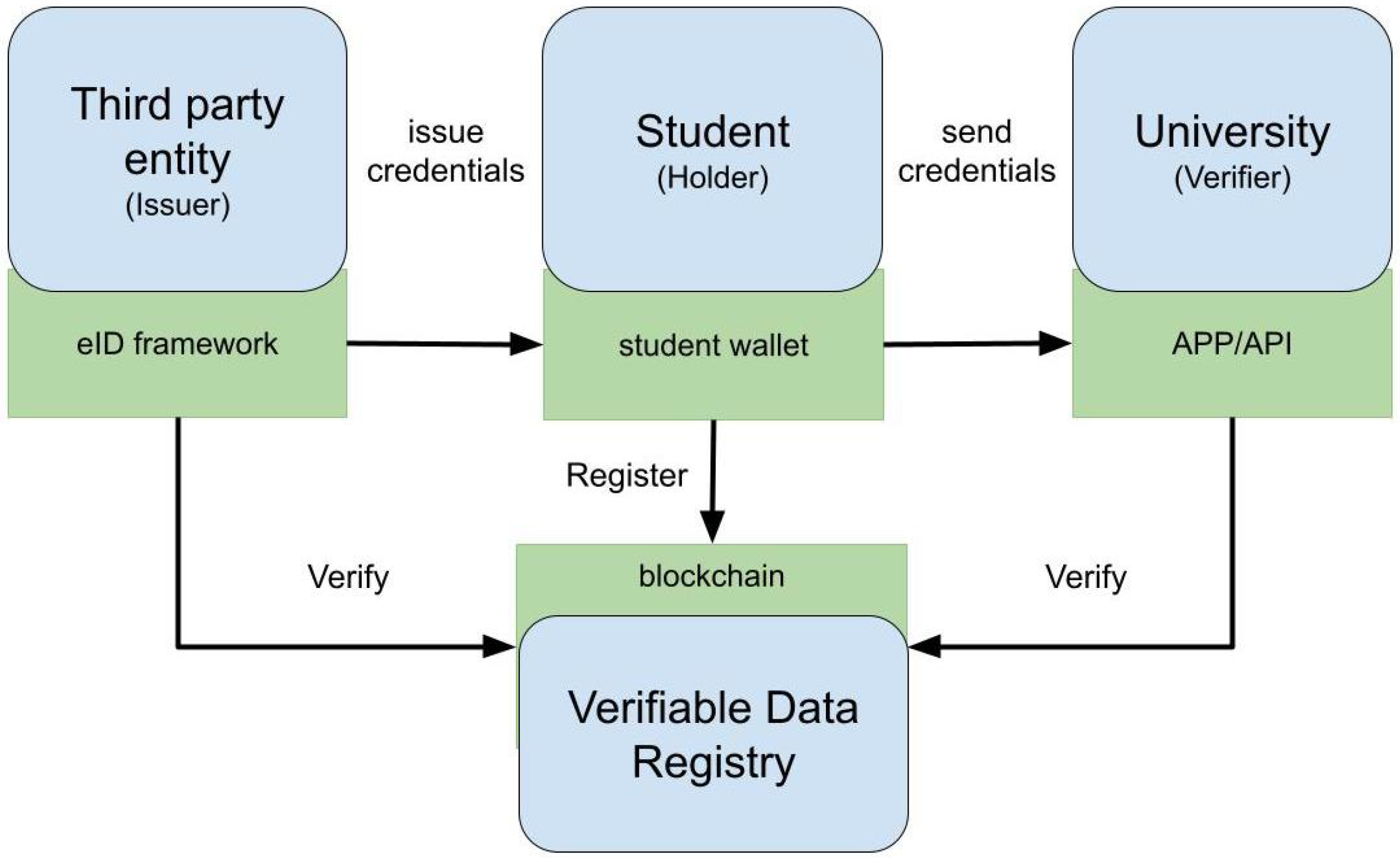
| Threats | Causes |
|---|---|
| Identity sprawl, identity theft | Lack of standards and portability |
| Personal data dispersion and proliferation | Lack of interoperability, fragmentation |
| Lose of control of data, data lock-in or misuse | Centralization |
| Illegal tracking or sniffing | Wearable devices |
| Heterogeneity of models | Lack of standard formats and reference architectures |
| Difficulties in accessing HDT | Lack of user-friendly platforms |
| Identity theft, illegal embodiment | Difficulties in binding real person with avatars |
| Poor user experience | Continuous and advanced authentication which can compromise the usability of tools |
Disclaimer/Publisher’s Note: The statements, opinions and data contained in all publications are solely those of the individual author(s) and contributor(s) and not of MDPI and/or the editor(s). MDPI and/or the editor(s) disclaim responsibility for any injury to people or property resulting from any ideas, methods, instructions or products referred to in the content. |
© 2024 by the authors. Licensee MDPI, Basel, Switzerland. This article is an open access article distributed under the terms and conditions of the Creative Commons Attribution (CC BY) license (https://creativecommons.org/licenses/by/4.0/).
Share and Cite
Ruiu, P.; Nitti, M.; Pilloni, V.; Cadoni, M.; Grosso, E.; Fadda, M. Metaverse & Human Digital Twin: Digital Identity, Biometrics, and Privacy in the Future Virtual Worlds. Multimodal Technol. Interact. 2024, 8, 48. https://doi.org/10.3390/mti8060048
Ruiu P, Nitti M, Pilloni V, Cadoni M, Grosso E, Fadda M. Metaverse & Human Digital Twin: Digital Identity, Biometrics, and Privacy in the Future Virtual Worlds. Multimodal Technologies and Interaction. 2024; 8(6):48. https://doi.org/10.3390/mti8060048
Chicago/Turabian StyleRuiu, Pietro, Michele Nitti, Virginia Pilloni, Marinella Cadoni, Enrico Grosso, and Mauro Fadda. 2024. "Metaverse & Human Digital Twin: Digital Identity, Biometrics, and Privacy in the Future Virtual Worlds" Multimodal Technologies and Interaction 8, no. 6: 48. https://doi.org/10.3390/mti8060048
APA StyleRuiu, P., Nitti, M., Pilloni, V., Cadoni, M., Grosso, E., & Fadda, M. (2024). Metaverse & Human Digital Twin: Digital Identity, Biometrics, and Privacy in the Future Virtual Worlds. Multimodal Technologies and Interaction, 8(6), 48. https://doi.org/10.3390/mti8060048










